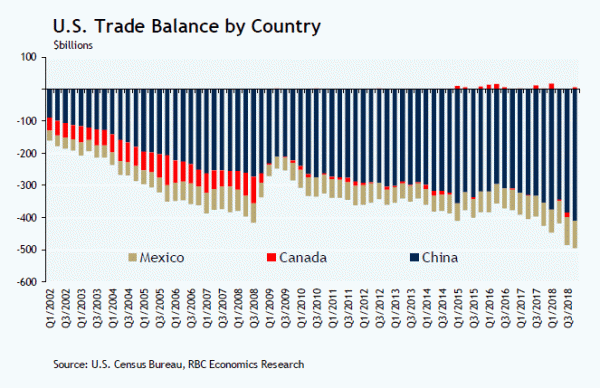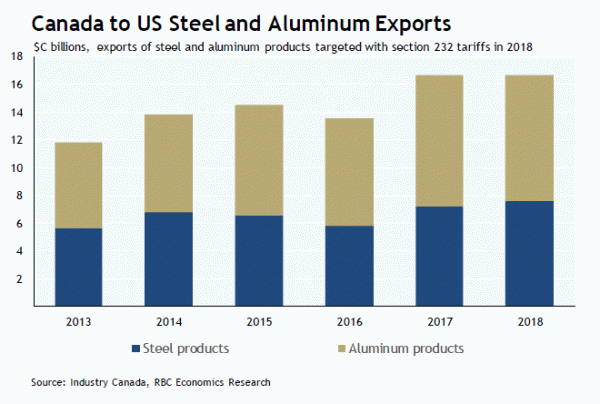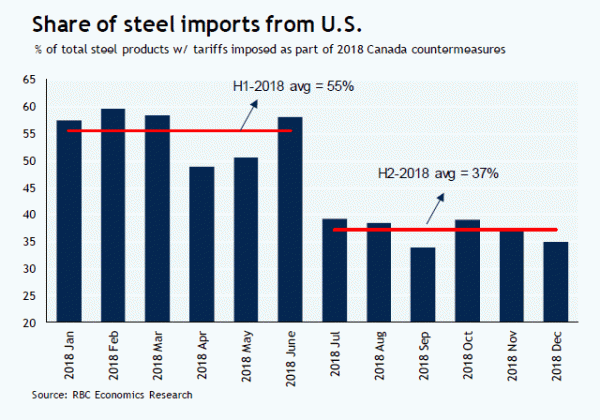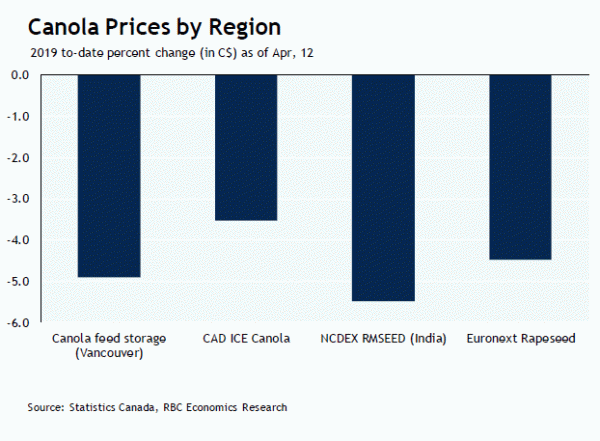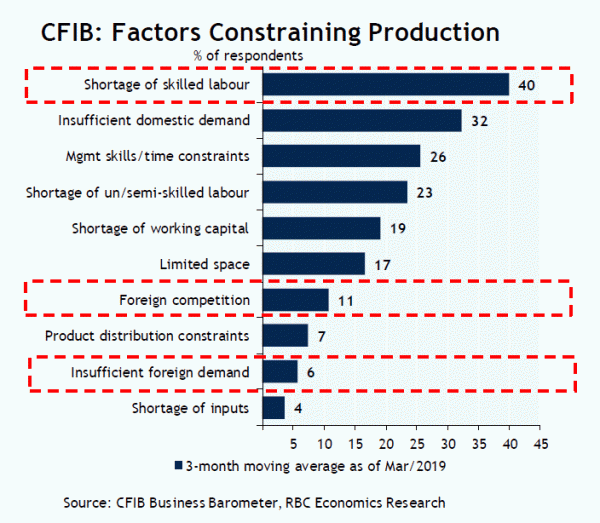Trade disruptions to date likely haven’t had a significant impact, growth challenges are more fundamental
U.S.-initiated global trade spats have caused hand-wringing in policy circles, and significant disruptions for some businesses. Sentiment aside, the actual economic impact of the disputes has been relatively muted. And the spats don’t fully explain the recent broad slowdown in global growth. In Canada and most other advanced economies, the overarching problem is that activity is running close to long-run capacity limits. That’s a good problem from a worker’s perspective, and explains why unemployment rates are around multi-decade lows in many countries, including Canada. It also makes it tougher for economies, including Canada’s, to grow significantly above longer-run trend rates even if trade tensions ease in the near term. So don’t bet on a dramatic boost to global economic growth if those tensions dissipate.
Putting the economic impact of trade disputes in context
About $340 billion of bilateral US-China trade has been subjected to new tariffs over the last year. That’s an eye-popping number. But relatively speaking, it is still not that big compared to total trade flows for the two countries. Total US trade in 2018 was $5.7 trillion. China’s was $5 trillion. In all, US import duties increased by about 1 percentage point as a share of total imports last year. That 1-percentagepoint tariff hike, on average, is probably not big enough to be very damaging to the broader macroeconomic backdrop.
Nor have more aggressive US trade policies done much to reduce its trade ‘imbalances.’ The U.S. posted its largest trade deficit in history with China in Q4/2018, despite punitive measures put in place throughout the year.
Easing of US-China trade tensions won’t mean immediate end of Canada’s own trade irritants
It increasingly looks like the US won’t ratify NAFTA’s replacement. Still, NAFTA remains in the mean-time. So the odds of some form of free trade in North America similar to the status quo staying in place are still significantly higher today than they were a year ago when the new agreement was still being renegotiated.
U.S. tariffs on Canadian steel and aluminum also remain in place. But the products targeted account for a relatively small 3% of Canadian merchandise exports. And exports of those products to the U.S. rose last year with U.S. producers and consumers seemingly forced to eat much of the tariff cost. Canada’s retaliatory tariffs on U.S.-made products increased costs for Canadian purchasers too – but Canadian buyers seem to have been more successful at finding alternative markets. Imports of steel products targeted in the retaliatory measures increased about 5% in the second half of last year from the prior year, but the share coming from the US fell from about 55% ahead of the tariffs to under 40% after. Imports of all products targeted in Canada’s retaliatory measures – the 25% steel tariffs plus 10% tariffs on aluminum and a mix of other products – increased ~2% over that period despite a 12% drop in those sourced from the U.S.
As in the US, new import duties have increased by about a percentage point as a share of total imports in Canada – probably not large enough to be a significant impediment to growth.
Canada has its own trade tensions with China
China imposed an effective ban on imports of Canadian canola as of March, ostensibly over pest issues but likely for political reasons. Although there could be some disruption to near-term trade flows, bilateral trading relationships typically matter far less in determining price for products like field crops than global supply and demand conditions. And price is ultimately what matters for domestic producers. Canola prices are down year-to-date, but not just in Canada, and most of the decline came before Chinese import restrictions were announced. From a macroeconomic perspective, the impact is limited. Canola exports accounted for about 10% of merchandise exports to China last year, but were about 0.5% of total Canadian goods exports. Overall, China accounted for about 5% of total Canadian goods exports last year.
Capacity constraints will limit the upside from easing tensions
The more fundamental barrier to growth is that in most of Canada the economy is already running pretty close to long-run capacity limits. The number of businesses reporting labour shortages fell sharply in the Bank of Canada’s closely watched Business Outlook Survey for Q1. But that wasn’t entirely unexpected, given slower GDP growth in Q4 and Q1 due to (likely transitory) disruptions to oil & gas production. The unemployment rate remains right around multi-decade lows, and it is tough to imagine it moving (sustainably) much lower. Businesses continue to report labour shortages as a major obstacle to expansion. Growth in the pool of available labour will continue to be restrained by an aging population. About 250k workers, roughly 1 ¼% of the labour force, are retiring each year. And higher interest rates have increased Canadian workers’ debt-servicing costs.
The picture is similar elsewhere. The US is dealing with its own labour shortages. And the economic boost it got last year from government tax cuts and spending increases won’t likely be repeated anytime soon. In China, the echoes of the ‘onechild’ policy mean the working-age population is already declining. Given that demographic headwind, it would not be surprising for China’s growth to continue to slow gradually minus a big spike in productivity. Easing trade tensions will do nothing to change that fundamental backdrop.
Where easing of trade tensions could help: restarting investment plans
While actual trade actions to date have impacted a relatively small share of Canadian businesses, a larger number have probably paused investment plans due to uncertainty around the global economic outlook. So resolving trade disputes could pull some business investment off the sidelines. That said, it’s important to remember that foreign trade issues are not the only concerns for Canadian businesses. Indeed, “insufficient foreign demand” and “foreign competition” rank near the bottom of the list of business concerns in data from the Canadian Federation of Independent Business.




